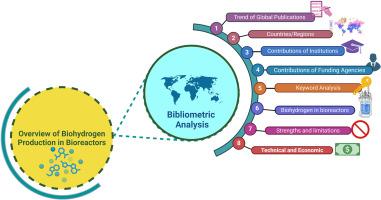Biohydrogen production in bioreactors: Global trends, key factors, and emerging directions
IF 8.1
2区 工程技术
Q1 CHEMISTRY, PHYSICAL
引用次数: 0
Abstract
This study delves into the burgeoning realm of biohydrogen production from renewable resources, with a particular focus on the role of bioreactors in addressing the worldwide demand for sustainable energy. It highlights the importance of selecting appropriate microorganisms, optimizing cultivation conditions, and designing efficient bioreactors. The research demonstrates how utilizing agricultural and industrial waste can substantially cut greenhouse gas emissions. A bibliometric analysis shows a marked increase in publications, with China initially at the forefront, though India is rapidly gaining ground. While China leads regarding the H-index and citations, notable contributions come from India and South Korea. Funding from agencies in China and Brazil, as are contributions from specific scientific journals, is crucial. Co-authorship and co-citation analysis pinpoint key researchers and collaborative networks. Moreover, keyword trends like "dark fermentation," "Enterobacter aerogenes," and "lignocellulosic biomass" indicate evolving research directions. Overall, the findings highlight China's dominance in the field and offer strategic insights into future developments in biohydrogen production for cleaner energy solutions.

生物反应器中的生物氢生产:全球趋势、关键因素和新兴方向
本研究深入探讨了利用可再生资源生产生物氢这一新兴领域,尤其关注生物反应器在满足全球对可持续能源需求方面的作用。它强调了选择适当微生物、优化培养条件和设计高效生物反应器的重要性。研究表明,利用农业和工业废弃物可以大幅减少温室气体排放。文献计量学分析表明,论文数量显著增加,中国最初处于领先地位,但印度正在迅速崛起。虽然中国在 H 指数和引文方面领先,但印度和韩国也做出了显著贡献。中国和巴西机构的资助以及特定科学期刊的贡献至关重要。合著和合引分析可以确定关键研究人员和合作网络。此外,"黑暗发酵"、"产气肠杆菌 "和 "木质纤维素生物质 "等关键词趋势也表明了不断发展的研究方向。总之,研究结果凸显了中国在该领域的主导地位,并为未来清洁能源解决方案生物制氢的发展提供了战略性见解。
本文章由计算机程序翻译,如有差异,请以英文原文为准。
求助全文
约1分钟内获得全文
求助全文
来源期刊

International Journal of Hydrogen Energy
工程技术-环境科学
CiteScore
13.50
自引率
25.00%
发文量
3502
审稿时长
60 days
期刊介绍:
The objective of the International Journal of Hydrogen Energy is to facilitate the exchange of new ideas, technological advancements, and research findings in the field of Hydrogen Energy among scientists and engineers worldwide. This journal showcases original research, both analytical and experimental, covering various aspects of Hydrogen Energy. These include production, storage, transmission, utilization, enabling technologies, environmental impact, economic considerations, and global perspectives on hydrogen and its carriers such as NH3, CH4, alcohols, etc.
The utilization aspect encompasses various methods such as thermochemical (combustion), photochemical, electrochemical (fuel cells), and nuclear conversion of hydrogen, hydrogen isotopes, and hydrogen carriers into thermal, mechanical, and electrical energies. The applications of these energies can be found in transportation (including aerospace), industrial, commercial, and residential sectors.
 求助内容:
求助内容: 应助结果提醒方式:
应助结果提醒方式:


